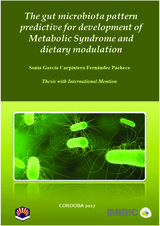Mostrar el registro sencillo del ítem
The gut microbiota pattern predictive for development of Metabolic Syndrome and dietary modulation
| dc.contributor.advisor | Pérez Jiménez, Francisco | |
| dc.contributor.advisor | Camargo García, A. | |
| dc.contributor.author | García-Carpintero Fernández-Pacheco, Sonia | |
| dc.date.accessioned | 2017-12-04T08:15:45Z | |
| dc.date.available | 2017-12-04T08:15:45Z | |
| dc.date.issued | 2017 | |
| dc.identifier.uri | http://hdl.handle.net/10396/15625 | |
| dc.description.abstract | Introduction: The metabolic syndrome (MetS) is a condition characterized by a cluster of metabolic disorders including abdominal obesity, glucose intolerance, dyslipidemia and hypertension. The MetS is related with the increasing prevalence of cardiovascular disease (CVD) and type-2 diabetes mellitus (T2DM). The gut microbiota is a complex ecosystem consisted of trillions of microbes that have co-evolved with their host for hundreds of millions of years. During the last decade, a growing body of knowledge has suggested that there is a compelling set of connections among diet, gut microbiota and human health. At present, it is known that microbial imbalance or dysbiosis of the gut microbiota is associated with metabolic disorders such as MetS, obesity, T2DM and CVD. In this context, the relationship between the composition of the intestinal microbiota and human health has led to the design of strategies to promote the prevalence of beneficial bacteria that improve health status. In this sense, studies are needed to research the possibility the develop strategies to dilute microbial patterns associated with metabolic diseases with the aim of predict and treat the course of the disease. Hypothesis: Our hypothesis is the existence of a gut microbiota pattern predicts the development of MetS. On the other hand, the null hypothesis is the absence of a specific pattern capable of predicting the development of MetS. Objectives: Main objective: To determinate whether the composition of the intestinal microbiota and fasting and postprandial levels of Lipopolysaccharide (LPS) and Lipopolysaccharide Binding Protein (LBP) might predict the development of MetS, defined by the criteria established by National Cholesterol Education Programme Adult Treatment Panel III (NCEP ATP III) for MetS, in a subpopulation of patients within the CORDIOPREV study with coronary heart disease. Secondary objectives: 1) To evaluate whether the chronic consumption of two healthy diets (Mediterranean diet and low-fat diet) may restore the gut microbiome dysbiosis in obese patients depending on the degree of metabolic dysfunction. 2) To analyze the differences in the composition of the intestinal microbiota and plasma levels of LPS after consumption of two healthy diets (Mediterranean diet and low-fat diet) for 3 years in PreDM patients who regressed from Normoglucemia (NGC) compared with patients who did not regressed during these time periods. | es_ES |
| dc.description.abstract | Introduccion: El síndrome metabólico (SMet) es una afección caracterizada por un grupo de alteraciones metabólicas que incluyen, entre otras, obesidad abdominal, intolerancia a la glucosa, dislipidemia e hipertensión. Este síndrome está implicado en la creciente prevalencia de enfermedades cardiovasculares y diabetes mellitus tipo 2 (DM2). La microbiota intestinal es un ecosistema complejo formado por billones de microbios que han coevolucionado con su huésped durante cientos de millones de años. En la actualidad, se sabe que el desequilibrio microbiano, disbiosis de la microbiota intestinal se asocia con trastornos metabólicos tales como el propio SMet, Obesidad, DM2 y Enfermedad Cardiovascular (CVD). En este contexto, la relación entre la composición de la microbiota intestinal y la salud humana ha llevado al diseño de estrategias para promover la prevalencia de bacterias beneficiarias que pudieran mejorar el estado de salud. En este sentido sería de interés la búsqueda de patrones microbianos asociados a enfermedades metabólicas con el objetivo de predecir y tratar la enfermedad. Hipotesis: Nuestra hipótesis consiste en que existe un patrón de microbiota intestinal capaz de predecir el desarrollo de SMet. Por otro lado, la hipótesis nula es la ausencia de un patrón específico capaz de predecir el desarrollo de SMet. Objetivos: Objetivo principal: Establecer que la composición de la microbiota intestinal y los niveles plasmáticos de Lipopolisacárido (LPS) y Proteína de unión a lipopolisacárido (LBP) pueden predecir el desarrollo de SMet, definido a través de los criterios establecidos por NCEP ATP III para SMet, en una subpoblación de pacientes del estudio CORDIOPREV con enfermedad coronaria. Objetivos secundarios: 1) Evaluar si el consumo crónico de dos dietas saludables (dieta mediterránea y dieta baja en grasas) puede restaurar la disbiosis de la microbiota intestinal en pacientes obesos dependiendo del grado de disfunción metabólica. 2) Analizar las diferencias en la composición de la microbiota intestinal y los niveles plasmáticos de LPS después del consumo, durante 3 años, de dos dietas saludables (dieta mediterránea y dieta baja en grasa) en pacientes PreDM que regresaron a Normoglucemia (NGC) comparado con pacientes que no regresaron. | es_ES |
| dc.format.mimetype | application/pdf | es_ES |
| dc.language.iso | eng | es_ES |
| dc.publisher | Universidad de Córdoba, UCOPress | es_ES |
| dc.rights | https://creativecommons.org/licenses/by-nc-nd/4.0/ | es_ES |
| dc.subject | Metabolic syndrome | es_ES |
| dc.subject | Metabolic diseases | es_ES |
| dc.subject | Digestive system | es_ES |
| dc.subject | Intestinal microbiota | es_ES |
| dc.subject | Microbial patterns | es_ES |
| dc.subject | Diet | es_ES |
| dc.subject | Síndrome metabólico | es_ES |
| dc.subject | Enfermedades metabólicas | es_ES |
| dc.subject | Sistema digestivo | es_ES |
| dc.subject | Microbiota intestinal | es_ES |
| dc.subject | Patrones microbianos | es_ES |
| dc.subject | Dieta | es_ES |
| dc.title | The gut microbiota pattern predictive for development of Metabolic Syndrome and dietary modulation | es_ES |
| dc.type | info:eu-repo/semantics/doctoralThesis | es_ES |
| dc.rights.accessRights | info:eu-repo/semantics/openAccess | es_ES |

